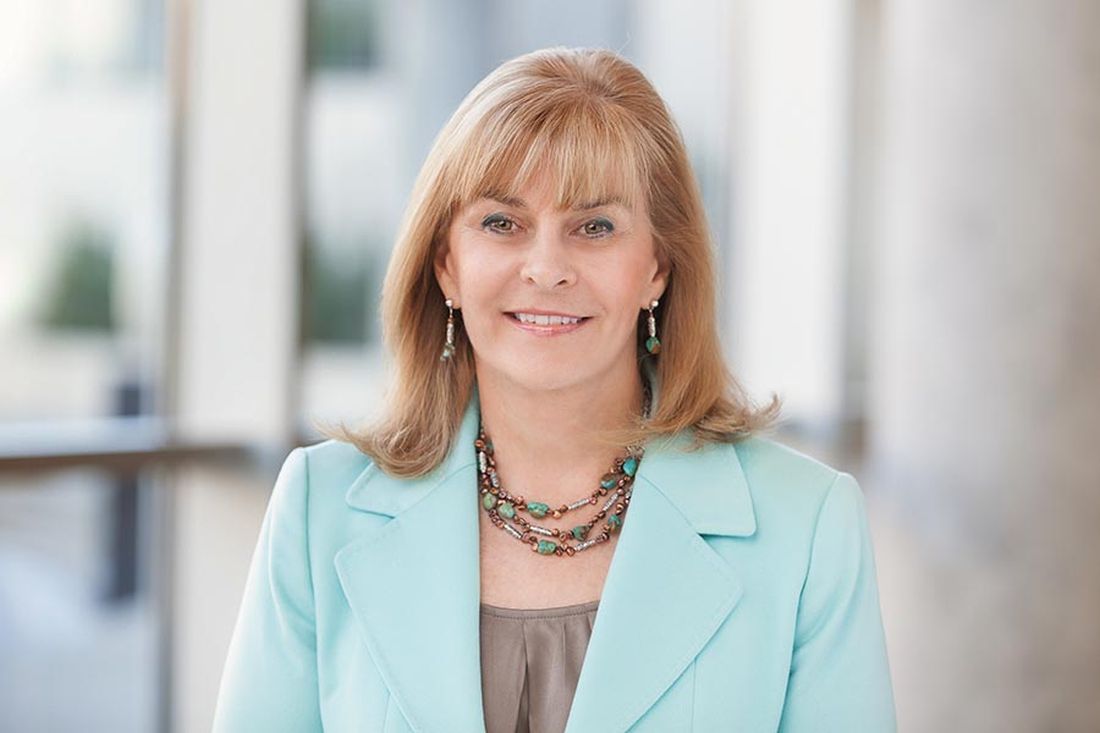User login
“Over the past 5 years, researchers have gotten a clearer picture of the different subtypes of peripheral T-cell lymphomas, and with this knowledge we are trying to identify potential targets of new treatments. Despite some progress, the need for these new treatments is still acute, due to the disease’s many subtypes and the difficulty of enrolling sufficient numbers of patients in clinical trials,” said Julie M. Vose, MD, MBA, of the University of Nebraska Medical Center, Omaha, speaking at the Lymphoma, Leukemia and Myeloma Congress 2023, in New York. Before her presentation at this year’s conference, Dr. Vose was awarded the SASS-ARENA Foundation’s John Ultmann Award for Major Contributions to Lymphoma Research.
Dr. Vose noted that only one subtype of PTCL, ALK+ ALCL, responds well to frontline treatment with CHOP (cyclophosphamide, doxorubicin, vincristine, prednisolone). Patients with the ALK+ ALCL signature treated with CHOP have a 5-year overall survival (OS) rate of 70%-90%, but this group only makes up about 6% of PTCL cases in North America, she added.
One of the most promising breakthroughs in treatment has been the addition of the anti-CD30 antibody-drug conjugate brentuximab vedotin (BV) to chemotherapy with CHP (cyclophosphamide, doxorubicin, prednisone), Dr. Vose said. Results from the ECHELON-2 trial indicate that CD30+ PTCL patients have improved performance with R-CHP, compared with CHOP; 5-year progression free survival (PFS) rates were 51.4% with R+CHP versus 43.0% with CHOP, and 5-year overall survival rates were 70.1% versus 61.0%, respectively.
“ALCL is one of the most prevalent PTCL subtypes and accounts for about 24% of all PTCL; the current standard-of-care for induction treatment in these patients is BV-CHP,” said Jia Ruan, MD, PhD, of Weill Cornell Medicine in New York. Dr. Ruan explained the limitation of adding BV-CHP, saying “We don’t have as effective biological targeted therapies in other subtypes of T-cell lymphoma, such as PTCL NOS [not-other specified] or angioimmunoblastic T-cell lymphoma.”
There is evidence that autologous stem cell transplant (ACST) can increase PFS and OS in newly diagnosed patients with angioimmunoblastic T-cell lymphoma (AITL), but not in patients with other types of newly diagnosed PTCL. The estimated 2-year OS and PFS for patients with AITL who received ASCT + chemotherapy were 93.3% and 68.8 respectively versus 52.9% and 41.2 in the non-ASCT group. This news is promising, yet Dr. Vose presented statistics indicating that AITL PTCL has been estimated to account for less than 19% of PTCL cases.
Despite the improvements in PFS and OS in a few subtypes for frontline PTCL, 60% of patients with non-ALCL PTCL will relapse, and relapsed/ refractory (R/R) PTCL patients have a median PFS of 9.6 months. Several studies have shown some promise for improving outcomes in R/R PTCL patients, such as the phase-II PRIMO study of duvelisib (a dual PI3K-delta,gamma inhibitor), in which there was an overall response rate of 50% and a complete response rate of 32%. Despite these modest gains, the prognosis for most PTCL patients remains poor. Dr. Vose concluded her presentation by reiterating the need for new agents and for further research. She emphasized that studies will need to be collaborative and international to enroll sufficient patients.
Dr Ruan drew a similar conclusion, noting “We need to increase clinical, translational and basic research on a collaborative scale, so that we can advance bench-to-bedside discovery and bring new treatment to patients quickly.”
Dr. Vose disclosed research funding from Epizyme, GenMab, Kite, Novartis, and Lilly. Dr. Ruan disclosed clinical research trial support from BMS and Daiichi Sankyo.
“Over the past 5 years, researchers have gotten a clearer picture of the different subtypes of peripheral T-cell lymphomas, and with this knowledge we are trying to identify potential targets of new treatments. Despite some progress, the need for these new treatments is still acute, due to the disease’s many subtypes and the difficulty of enrolling sufficient numbers of patients in clinical trials,” said Julie M. Vose, MD, MBA, of the University of Nebraska Medical Center, Omaha, speaking at the Lymphoma, Leukemia and Myeloma Congress 2023, in New York. Before her presentation at this year’s conference, Dr. Vose was awarded the SASS-ARENA Foundation’s John Ultmann Award for Major Contributions to Lymphoma Research.
Dr. Vose noted that only one subtype of PTCL, ALK+ ALCL, responds well to frontline treatment with CHOP (cyclophosphamide, doxorubicin, vincristine, prednisolone). Patients with the ALK+ ALCL signature treated with CHOP have a 5-year overall survival (OS) rate of 70%-90%, but this group only makes up about 6% of PTCL cases in North America, she added.
One of the most promising breakthroughs in treatment has been the addition of the anti-CD30 antibody-drug conjugate brentuximab vedotin (BV) to chemotherapy with CHP (cyclophosphamide, doxorubicin, prednisone), Dr. Vose said. Results from the ECHELON-2 trial indicate that CD30+ PTCL patients have improved performance with R-CHP, compared with CHOP; 5-year progression free survival (PFS) rates were 51.4% with R+CHP versus 43.0% with CHOP, and 5-year overall survival rates were 70.1% versus 61.0%, respectively.
“ALCL is one of the most prevalent PTCL subtypes and accounts for about 24% of all PTCL; the current standard-of-care for induction treatment in these patients is BV-CHP,” said Jia Ruan, MD, PhD, of Weill Cornell Medicine in New York. Dr. Ruan explained the limitation of adding BV-CHP, saying “We don’t have as effective biological targeted therapies in other subtypes of T-cell lymphoma, such as PTCL NOS [not-other specified] or angioimmunoblastic T-cell lymphoma.”
There is evidence that autologous stem cell transplant (ACST) can increase PFS and OS in newly diagnosed patients with angioimmunoblastic T-cell lymphoma (AITL), but not in patients with other types of newly diagnosed PTCL. The estimated 2-year OS and PFS for patients with AITL who received ASCT + chemotherapy were 93.3% and 68.8 respectively versus 52.9% and 41.2 in the non-ASCT group. This news is promising, yet Dr. Vose presented statistics indicating that AITL PTCL has been estimated to account for less than 19% of PTCL cases.
Despite the improvements in PFS and OS in a few subtypes for frontline PTCL, 60% of patients with non-ALCL PTCL will relapse, and relapsed/ refractory (R/R) PTCL patients have a median PFS of 9.6 months. Several studies have shown some promise for improving outcomes in R/R PTCL patients, such as the phase-II PRIMO study of duvelisib (a dual PI3K-delta,gamma inhibitor), in which there was an overall response rate of 50% and a complete response rate of 32%. Despite these modest gains, the prognosis for most PTCL patients remains poor. Dr. Vose concluded her presentation by reiterating the need for new agents and for further research. She emphasized that studies will need to be collaborative and international to enroll sufficient patients.
Dr Ruan drew a similar conclusion, noting “We need to increase clinical, translational and basic research on a collaborative scale, so that we can advance bench-to-bedside discovery and bring new treatment to patients quickly.”
Dr. Vose disclosed research funding from Epizyme, GenMab, Kite, Novartis, and Lilly. Dr. Ruan disclosed clinical research trial support from BMS and Daiichi Sankyo.
“Over the past 5 years, researchers have gotten a clearer picture of the different subtypes of peripheral T-cell lymphomas, and with this knowledge we are trying to identify potential targets of new treatments. Despite some progress, the need for these new treatments is still acute, due to the disease’s many subtypes and the difficulty of enrolling sufficient numbers of patients in clinical trials,” said Julie M. Vose, MD, MBA, of the University of Nebraska Medical Center, Omaha, speaking at the Lymphoma, Leukemia and Myeloma Congress 2023, in New York. Before her presentation at this year’s conference, Dr. Vose was awarded the SASS-ARENA Foundation’s John Ultmann Award for Major Contributions to Lymphoma Research.
Dr. Vose noted that only one subtype of PTCL, ALK+ ALCL, responds well to frontline treatment with CHOP (cyclophosphamide, doxorubicin, vincristine, prednisolone). Patients with the ALK+ ALCL signature treated with CHOP have a 5-year overall survival (OS) rate of 70%-90%, but this group only makes up about 6% of PTCL cases in North America, she added.
One of the most promising breakthroughs in treatment has been the addition of the anti-CD30 antibody-drug conjugate brentuximab vedotin (BV) to chemotherapy with CHP (cyclophosphamide, doxorubicin, prednisone), Dr. Vose said. Results from the ECHELON-2 trial indicate that CD30+ PTCL patients have improved performance with R-CHP, compared with CHOP; 5-year progression free survival (PFS) rates were 51.4% with R+CHP versus 43.0% with CHOP, and 5-year overall survival rates were 70.1% versus 61.0%, respectively.
“ALCL is one of the most prevalent PTCL subtypes and accounts for about 24% of all PTCL; the current standard-of-care for induction treatment in these patients is BV-CHP,” said Jia Ruan, MD, PhD, of Weill Cornell Medicine in New York. Dr. Ruan explained the limitation of adding BV-CHP, saying “We don’t have as effective biological targeted therapies in other subtypes of T-cell lymphoma, such as PTCL NOS [not-other specified] or angioimmunoblastic T-cell lymphoma.”
There is evidence that autologous stem cell transplant (ACST) can increase PFS and OS in newly diagnosed patients with angioimmunoblastic T-cell lymphoma (AITL), but not in patients with other types of newly diagnosed PTCL. The estimated 2-year OS and PFS for patients with AITL who received ASCT + chemotherapy were 93.3% and 68.8 respectively versus 52.9% and 41.2 in the non-ASCT group. This news is promising, yet Dr. Vose presented statistics indicating that AITL PTCL has been estimated to account for less than 19% of PTCL cases.
Despite the improvements in PFS and OS in a few subtypes for frontline PTCL, 60% of patients with non-ALCL PTCL will relapse, and relapsed/ refractory (R/R) PTCL patients have a median PFS of 9.6 months. Several studies have shown some promise for improving outcomes in R/R PTCL patients, such as the phase-II PRIMO study of duvelisib (a dual PI3K-delta,gamma inhibitor), in which there was an overall response rate of 50% and a complete response rate of 32%. Despite these modest gains, the prognosis for most PTCL patients remains poor. Dr. Vose concluded her presentation by reiterating the need for new agents and for further research. She emphasized that studies will need to be collaborative and international to enroll sufficient patients.
Dr Ruan drew a similar conclusion, noting “We need to increase clinical, translational and basic research on a collaborative scale, so that we can advance bench-to-bedside discovery and bring new treatment to patients quickly.”
Dr. Vose disclosed research funding from Epizyme, GenMab, Kite, Novartis, and Lilly. Dr. Ruan disclosed clinical research trial support from BMS and Daiichi Sankyo.
AT LLM CONGRESS 2023

